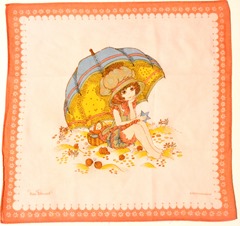Monique and I have been adding a lot of Drop the Handkerchief Games to Mama Lisa’s World. This got Monique thinking about the actual meaning of handkerchief in different languages. Here are some of her thoughts…
" I was thinking about the word for handkerchief in some languages and it’s funny what they literally mean.
I was thinking about the word for handkerchief in some languages and it’s funny what they literally mean.
In English, "handkerchief" is a kerchief you hold or take in your hand. "Kerchief" comes from the French term "couvre-chef" = "headcover" (headscarf). I didn’t know that!
In Italian, it’s Fazzoletto meaning "little fazzuolo" = "little kerchief".
In Spanish, it’s "pañuelo" meaning "little paño" = "little piece of fabric".
There’s also "mocador" in Spanish, which is the equivalent of the French "mouchoir" meaning "something to blow one’s nose with". In Occitan, the language of the Troubadours, it’s "mocador". The same meaning as French.
In Portuguese, it’s "lencinho" meaning "little lenço" = "little sheet" or "little piece of fabric".
In German it’s "Taschentuch" = "a cloth you put in your pocket"
What do you call a handkerchief in your language and what does it mean?"
-Monique
Monique Palomares works with me on the French and Spanish versions of Mama Lisa’s World. –Mama Lisa
This article was posted on Tuesday, October 21st, 2014 at 6:56 pm and is filed under Countries & Cultures, England, English, France, French, German, Germany, Handkerchief in Many Languages, Languages, Occitan, Occitan, Portugal, Portuguese, Spain, Spanish, USA, Words & Phrases. You can follow any responses to this entry through the RSS 2.0 feed. You can skip to the end and leave a response. Pinging is currently not allowed.
8 Responses to “The Meaning of Handkerchief Around the World”
Leave a Reply

























October 22nd, 2014 at 2:03 am
Here in Japan, handkerchief is “ハンカチha-n-ka-chi” written in four Japanese katakana letters and with no meaning-change. Every Japanese came to use it with the changing our clothes to western style. I suppose the word “handkerchief” came from the USA or UK.
While we were wearing kimonos, old clothes, we used “tenugui”, a hand towel made of cotton that is typically about 35 by 90 centimeters in size. Since every kimono doesn’t have any pockets, we held it with a belt, “obi”, or in a breast slot (or lining) of the kimono. And it was worn as a headband (or sweatband) for workers such as carpenters etc.
We never use handkerchiefs or tenuguis for wiping nasal discharge. For Japanese, the “nasal discharge”,”phlegm” or “spit” feels so dirty. Please imagine a scene as follows;
When someone came to Japan, he/she made a sneeze and wiped the nasal discharge with one’s handkerchief. Then he/she went to a wash room and used the same handkerchief to wipe the hands after that. And he/she would hold out the right hand to me saying “How do you do? Very happy to meet you.” We never refuse shaking a hand, but we don’t feel good about it in that case. We use tissue papers on such an occasion. In front of almost every train station, you can get small tissue papers with a sheet of paper of advertizing from some ad-men or ad-women.
We use handkerchiefs for wiping off water from our hands, for sweat, and tears. When we are watching movies of tragic love stories, or attending a funeral ceremony, it will be an important item especially for ladies.
There are various designed handkerchiefs in beautiful colors, but for the ceremony such as marriage, funeral, or formal ceremony, we should bring a white handkerchief with a formal black coat especially for gentlemen. I suppose it will be the same as European countries and the USA.
October 22nd, 2014 at 11:47 am
Thank you for writing Sadao! That’s interesting.
Here in the US, in my experience, not many people use handkerchiefs any more. The one place they use it is for ornamental reasons – a man might wear a little one in the breast pocket of his suit and have the fabric show a little.
I think my father’s generation used handkerchiefs (maybe men more than women?). Perhaps they used them before there were disposable tissues cheaply available. I think they were used for blowing the nose… but not for wiping the hands.
In an old movie you might see a man offering a woman who’s crying his handkerchief. In that case, I always assumed he had not used it to blow his nose and that it was clean.
It would be interesting to know where handkerchiefs are still used and what they’re used for.
To me they’re very old-fashioned.
-Mama Lisa
October 23rd, 2014 at 12:39 pm
Maryann wrote on our Facebook Group:
“My mother wore plain lace kerchiefs to cover her head for church. I’d get a small handkerchief fastened onto my head with a bobby pin. Since I don’t use them anymore…..I thought about making a quilt out of these vintage materials collected from my family members. Many of the handkerchiefs came from Italy. My old family photos have both men and women from the 1920’s – 1970’s in New York city with a hanky.”
October 28th, 2014 at 4:40 am
Thank you Lisa,
I am very glad to share same information with you.
I looked in my dictironary, Oxford Advanced Learner’s Dictionary 7th edtion, it says “handkerchief; a small piece of material or paper that you use for blowing your nose, etc.”
And I serched on the net as the keyword in Japanese “ハンカチで鼻=(wipe)nose by a handkerchief”. Then I found the similar troubles that talking a Japanese girl like as I said. In that page some English or French people using handkerchief to blow nose, the Japanese are talking.
Anyway we are glad to know about differences in various cultures.
And next I recommend you all to search and read in the “wikipedia”by the keyword, “tenugui”, “furoshiki”, and also “handkerchierf”. All are piece of cloths.
November 13th, 2014 at 5:11 pm
my mother came from Germany, I was born in 1950 in Yuba City CA. my father’s family are mechanics and farmers. Every grown man had a huge white handkerchief kept in the back pocket. As long as it stayed clean, we used them for blowing your nose or wiping sweat. most men at that time do the blowing mucus out the nose on the ground (we’re in farmland) my grandpa and my dad used handkerchiefs for wiping off their hands after doing a greasy chore. Usually you wash your handkerchiefs with bleach and hot water along with the underwear and sock. I had a huge handkerchief, with varying borders for blowing my nose. My mom did not spend money on throwaway Kleenex. It is also ecologically efficient to use a handkerchief,you just gotta be aware of the disease co-efficient. does anyone know of a rythym/rhyme about polishing shoes – Steifelputzer war my vater??? thanks
November 14th, 2014 at 6:06 pm
Sadao wrote from Japan that it’s normal to try not to make noise while blowing your nose in Japan.
I responded that here in the US, woman especially try not to make loud noises when they blow their noses in public. Men don’t worry quite as much.
It’s interesting that there’s an etiquette around the world about this!
February 12th, 2018 at 11:14 am
A white handkerchief meant: “I love you,” while a lilac-colored handkerchief meant: “Wait for me at your window tomorrow, my love, I will give you a letter.” A light green handkerchief referred to being cautious and a purple one meant: “I really like you.” Also, a handkerchief with pink corners meant: “I cannot live without you,” a yellow one: “I was sick for the last few days, I could not go out.” A handkerchief with green corner meant: “I will always remain loyal to you,” a red one: “I love you with my whole heart,” a blue one: “You are not grateful, I am in sorrow,” and a green one meant: “I sent you a letter and am awaiting your answer.”
December 10th, 2019 at 3:42 am
I use hankies everyday all day long. I have many and wash them often. I feel so lost if I don’t have one on me or in my purse. I don’t like the lint that kleenex tissues produce.